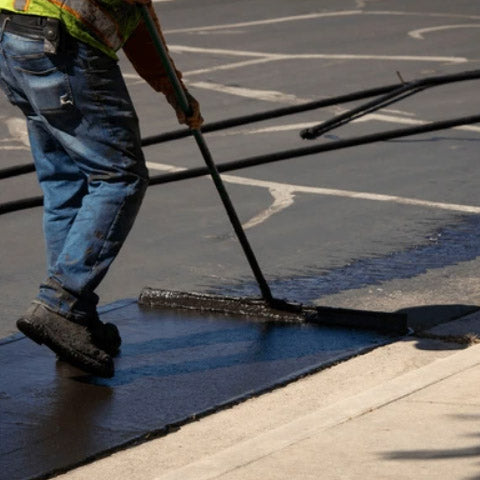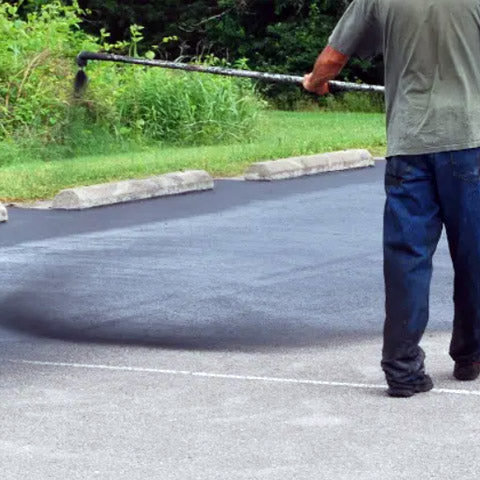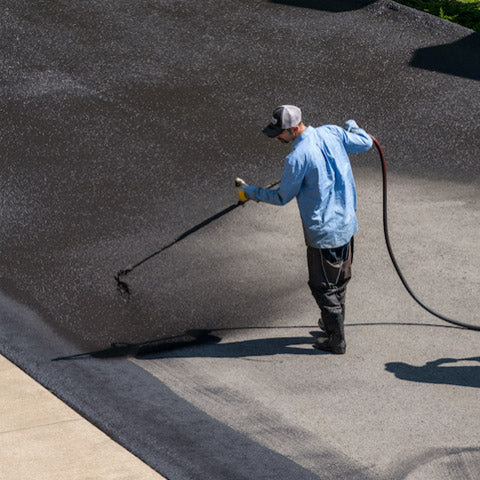Understanding the Difference: Asphalt Sealcoating vs. Resurfacing
Asphalt surfaces, whether a driveway or parking lot, require regular maintenance to extend their lifespan and maintain their appearance. Two primary methods for maintaining asphalt are resurfacing and sealcoating. Often, property owners find themselves asking, what is the difference between asphalt resurfacing and asphalt sealing?
The short answer is: For maintaining and extending the life of your existing asphalt pavement, sealcoating is often the more cost-effective and less invasive option compared to resurfacing, especially for asphalt pavement with minimal damage.
This article aims to shed light on both methods, helping you make an informed decision about maintaining your asphalt pavement.
Understanding Asphalt Resurfacing

Asphalt resurfacing, often referred to as overlaying, is a method of asphalt pavement rehabilitation that involves the application of a new layer of asphalt over the initial asphalt pavement. This process is typically considered when the asphalt pavement shows signs of significant wear and tear, such as large cracks, potholes, and overall crumbling asphalt surface, but the foundation remains structurally sound.
The asphalt paving resurfacing process begins with a thorough cleaning of the existing pavement to remove debris and ensure a strong bond between the old and new layers. Any significant damages are repaired before resurfacing to ensure a uniform surface. Then, a new layer of asphalt, usually several inches thick, is applied and compacted. This not only restores the surface to its original smoothness but also adds strength and extends the lifespan of the pavement.
Resurfacing old pavement is particularly beneficial for surfaces that have undergone moderate to severe distress but do not require complete reconstruction. It is a cost-effective way to enhance the appearance and functionality of asphalt paving, making it a popular choice for commercial and residential properties alike. Turning old pavement into new asphalt will change the look and feel of your business for years to come.
Understanding Sealcoating

Asphalt sealcoating, on the other hand, is a preventive maintenance method designed to protect and extend the life of asphalt pavements. It involves the application of a protective coating of asphalt sealcoat with an asphalt sealcoat machine, typically made of bituminous-based products or acrylics, over the existing asphalt surface. This coating serves as a barrier against various elements, including water, oils, UV rays, and other substances that can degrade asphalt.
The process starts with a thorough cleaning of the asphalt surface to ensure the sealcoat adheres properly. Filling in cracks and small potholes is necessary before sealcoating. Once the surface is prepared, the sealcoat material is applied evenly across the pavement. Fresh asphalt not only enhances the asphalt's appearance, giving it a fresh, dark finish but also seals small cracks to prevent water infiltration, which can lead to more significant damage. To learn more about crack repair be sure to check out our comprehensive guide.
Sealcoating is ideal for relatively new asphalt surfaces or those with minimal damage. It is a cost-effective way to prolong the pavement's life, preventing the need for more extensive and expensive repairs in the future. Regular sealcoating, typically every two to three years, can significantly extend the life of an asphalt surface.
Comparing Resurfacing and Sealcoating
When deciding between asphalt resurfacing and sealcoating, it's crucial to understand their differences, as each serves a distinct purpose in pavement maintenance.
Durability and Lifespan: Resurfacing adds a new layer of asphalt, significantly improving the pavement's structural integrity. This can extend the pavement's life by several years, depending on the traffic and environmental conditions. Sealcoating, while effective in protecting the asphalt surface, doesn't add structural strength but rather acts as a protective shield, delaying wear and tear. Regular sealcoating can extend the life of the pavement, but it will need to be reapplied more frequently than a resurfacing job.
Cost Considerations: Initially, sealcoating is less expensive than resurfacing. It's a cost-effective option for maintaining the asphalt's appearance and minor wear. Resurfacing, however, while more costly upfront, can be more economical in the long run for pavements that have sustained significant damage. It prevents the need for complete reconstruction, which is far more expensive.
Application Time and Convenience: Sealcoating is a quicker process and usually takes less time to dry and be ready for use. Resurfacing, involving the laying of a new asphalt layer, requires more time for application and setting. This could mean a longer downtime for the area being treated, which might be a consideration for businesses or homeowners.
Making the Right Choice: Why Sealcoating Trumps Resurfacing
When it comes to maintaining your asphalt pavement, the decision between resurfacing and sealcoating can significantly impact both the longevity of your pavement and your budget. While both methods have their merits, in many cases, sealcoating emerges as the preferable option.

-
Preservation and Preventive Maintenance: Sealcoating excels in preserving the existing asphalt and preventing further damage. By forming a protective layer, it shields the pavement from water, oils, UV rays, and other damaging elements. This proactive approach can greatly extend the life of your asphalt without the need for more invasive procedures like resurfacing.
-
Cost-Effectiveness: Sealcoating is notably more affordable than resurfacing. For property owners mindful of maintenance budgets, sealcoating provides an efficient way to maintain the pavement at a fraction of the cost of resurfacing. This affordability also allows for more regular maintenance, ensuring consistent protection over time.
-
Minimizing Disruption: Unlike resurfacing, which can be a time-intensive process, sealcoating is relatively quick to apply and cure. This means less downtime and disruption, whether it’s a driveway or parking lot. The convenience of sealcoating makes it an attractive option, especially for businesses that cannot afford lengthy closures.
-
Aesthetic Improvement: Regular sealcoating not only protects but also enhances the appearance of asphalt pavement. It gives a fresh, clean, and uniform look, which can improve the overall curb appeal of your property.
-
Extending Pavement Life Before Resurfacing: In many scenarios, regular sealcoating can significantly delay the need for resurfacing. By maintaining the integrity of the asphalt, sealcoating extends the pavement's lifespan, allowing you to postpone more costly resurfacing projects.
In summary, while resurfacing is undoubtedly beneficial for severely damaged asphalt, sealcoating offers a more practical, cost-effective solution for maintaining and protecting pavements that are in relatively good condition. It’s an investment in preventive care that pays off by extending the life of your asphalt, maintaining its appearance, and saving on future repair costs. For most property owners, regular sealcoating should be a key component of their asphalt maintenance strategy.
Conclusion: Embracing Sealcoating for Sustainable Asphalt Management
Sealcoating, with its ability to extend the life of your asphalt while being cost-effective and minimally invasive, is a wise choice for most asphalt maintenance scenarios. It's particularly suited for pavements that don't exhibit severe damage but require regular upkeep to maintain their integrity and appearance. By choosing sealcoating, you're not only saving on immediate costs but also investing in the long-term health and aesthetics of your pavement. Remember, consistent maintenance is key to avoiding major repairs, and sealcoating is a cornerstone of that maintenance strategy.
For personalized advice and high-quality sealcoating services, reach out to experienced professionals who can help you keep your asphalt in top condition.


